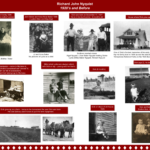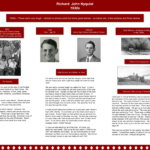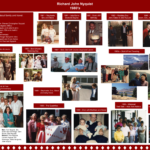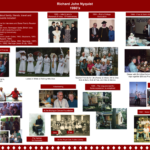I was born in a homestead house outside of the Northeastern Montana town of Froid with my grandmother, a nurse-midwife, in attendance. She had come over a hundred miles to be in attendance because winters are severe and our car was a Model T Ford. It was December, 1921.
We farmed with horses so there was work for both parents to the extent that I was left to my own devices from the age of three. Life was a great adventure for me. In 1925, my adventures included riding in a new Buick, traveling to Glacier and Yellowstone National Parks with my grandparents and parents. Other adventures included falling out of the hay barn, being fished out of the water tank, and walking several miles to watch Dad and Uncle Algot as they moved the sections of the old house as Uncle Algot and Aunt Lillian moved into their 3 bedroom Sears Roebuck home. I was also introduced to my new brother, Bob in December.
Other innovations in 1925 were the installation of surface wiring in the house and a new light plant with storage batteries. After that came a Maytag washing machine and a Zenith radio with 3 tuning knobs.
1926 was my big year. They moved the old house off its foundations, enlarged the cellar into a full basement and built a 3-bedroom house with a bathroom and 3 bedrooms upstairs. I got to oversee the digging of a cistern and then oversaw a neighbor who bought the old house and, by himself, jacked it up and put 2 wagons under it. Tractors then pulled it out and across the field to his homestead several miles away.
Threshing time was special. I got to see the threshing rig with the big old-fashioned monster tractor and the next year the new smaller tractor with a big shiny threshing machine that could build straw piles twenty feet high. I was also impressed by the cook shack on wheels, that could serve 16 men at a time.
I was on the farm until I started college so it meant living on a farm and going to grade school in a country school about 2 and a half miles from thee farm.
In 1929, I got my pony. Now I was on my own in getting to school, come rain, snow, or shine. Montana temperatures range from a high in summer of 110 or more and a low of 35 below in the dead of winter. There was so such thing as a snow day. We went to school regardless.
1929 was a year of looking forward. Many of the farmers including dad bought new equipment and more land. We not only bought more land but equipment and 8 more horses and harnesses to till the land. 1930 was a setback. Although crops were adequate, the prices of wheat and other farm products dropped. By the end of 1930, people were beginning to feel the pinch. Two of our neighbors lost their land that year
The depression years (1930-1942) were my formative years. As the oldest son, I was expected to, and accepted, a role of taking on burdens as I grew up. I was able to do a man’s work by the age of 15. I joined the 4-H program when I was eleven and took over the gardening. The produce I grew was an important part of our diet for the next eight years. Part of my job as a farmer ‘s son was to see what needed to be done without my Dad’s prompting, thus reducing his burden.
The drought years were from 1931 to 1938. Regular rainfall in Eastern Montana ranges from 14 to 15 inches of precipitation per year. Precipitation was below that every year and often at the wrong time. 1937 was a total crop failure with less than 8 inches in 12 months.
1931 was probably the worst year of the depression. The spring rains didn’t come until July, resulting in poorly developed grain but also promoting a large crop of thistles at the very time we needed to harvest. Wheat prices were down to .45 a bushel and our grain was badly developed and we were lucky to get .30 per bushel. There were no government programs and the banks were very short of cash. Most farmers were unable to pay more than a part of their taxes. Schools stayed closed that year. My brother Tom was also born that summer.
The winter of 1931 was difficult. The roads closed in December and Dad was the only one to go to town in two months and that by sleigh. Each Saturday he would make the trip, shipping our weekly can of cream to a creamery and buying a few necessities plus the Sunday Herald and Examiner. We still got a couple of magazines, one for us boys and one for Mother. The magazines and the Sunday Herald were read from cover to cover.
That Christmas was pretty slim. Our tree was 3 feet high and cost 25 cents. Bob and I each got a gift that cost less than 1.00. Our real Christmas was a bag of mixed nuts and a generous quantity of Christmas candy.
Our farm electric system quit working because the batteries were old and we had only one small lamp for the house and a kerosene lantern for outdoor work. In the house, we followed the lamp around. This was togetherness. The bathroom took too much cistern water so Mother was the only one to use the bathroom. We males had to use the outdoor privy. That was not easy when temperatures dropped to the minus 20’s.
Most of our neighbors survived the depression. It was mostly because they lived on family farms and everybody contributed to the effort of surviving until spring.
High School (1936-1940) was at Froid, 6 miles from the farm. I got there by horse, bicycle, riding with other students and, stayed in town during January and February of each year because the roads were snowed in. Dad would pick me up by sleigh each Friday and take me back to town early on Monday morning. My intense need to know took me to the encyclopedias quite frequently and I made frequent use of the unabridged dictionary. These trips eventually led to my nickname of “Doc”. My grades progressed from C plus to straight A’ by graduation time although I never pretended to be a competitive student.
I was called into service in September, 1942 but was not inducted until April, 1943. My military service was spent in training, first in basic, then in Indiana University. I spent two terms there and then was transferred to Camp Crowder to train for a signal center in the Signal Corps. My overseas service was less than six months when I developed blood poisoning from jungle fungus. The rest of my service was in the states where I served as a company clerk and casual worker.
I married Frances Carol Benjamin, a teacher in the Battle Creek school system, in 1946. She continued teaching while I attended College at Wayne State University in Detroit. I graduated in January, 1948 and returned to the farm until September. We had three children: Julie Gayle Nyquist (born in 1948, Richard John Nyquist, Jr. (born in 1952) and Robert Allen Nyquist (born in 1957). In 1949-50 I also built my own home and 40 year later in the 1990’s spent time helping my sons build additions to their homes, as well as one to our home.
I worked as an accountant from 1948 to 1990 with 3 years in retail, 28 years as a Corporation accountant and my final years as the accountant at the Pontiac, Michigan Teamsters Union.
Fran and I traveled a great deal during my working years including camping and touring in all but 4 of the United States as well as much of Southern Canada. We also made a number of trips to Europe including a long bus tour of Western Europe. We also made a long trip to Australia and New Zealand. My hobby was photography and I have 18,000 slides in my library, arranged in many categories.
We practiced ballroom dancing and belonged to a square dance club for many years. We also have belonged to a camping club since 1962.
I began writing in 1990 when I retired. Two years were spent in researching my family tree and visiting relatives and doing interviews of their lives. We also made 4 long overseas trips to Europe and China.
Fran passed away in December, 2002. Since then, I have spent much of my time researching my old love of History and Geography. My computer is an invaluable friend and tool. My particular concern today is the climate, as it will affect humanity and the growth in population. That has concerned me since the early 1970’’s when I first noted the alarming increase in the population of 3rd world countries.
I am presently working on an article titled “Archaeologilcene” the new era that has begun since the birth of the Industrial Age.










